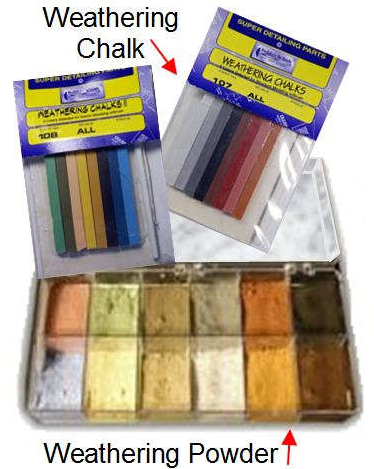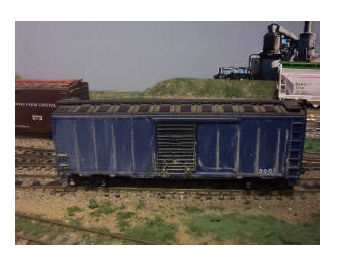4 Weathering Techniques To Bring Realism To Model Railroad Structures, Scenery and Trains
By Kevin C. © Copyright https://www.modelbuildings.org All rights reserved.
On real railroads the engines and wagons always look dirty rusty or have paint touch ups visible. So, on your model Railroad if you want the same effect you will have to do the effect yourself. You won’t be able to leave the model in the sun or outside weather… that would spell disaster for the model. The sun would warp the plastic assuming it was a plastic model.
1. Chalks and Powder
The most simple effect to start with is adding a bit of rust or dust to the model and the most simple medium to use would be weathering chalks, available at most hobby shops.
The beauty of these is that if you are not satisfied with the result simply wipe the model with a damp cloth to remove the chalk effect and start again. Start by using an older model perhaps one that is not being used as it could be broken or has wheels missing etc.
Firstly start by washing the model in warm soapy water and dry thoroughly. Handling of the car from this point should be done using surgical type gloves to stop getting finger prints on the model. Weathering chalk is available in stick or powder from in rust, earth, grime and grey tones. Chalks are best applied in powder form so if sticks are used you will also need some fine sand paper to rub the chalk stick on to make it a powder. Apply the powder with a soft brush a little at a time until you have the desired effect. With rust apply and run the brush vertical in downward strokes as if the wet weather has run the rust down the side of the car so you have rust at the top and it streaks to no rust at the bottom of the stroke. I use a fairly stiff artist brush for this that the bristles are flat and square at the end. It will take a bit of practice to get the strokes just right. One stroke for each rust spot so that you lose the powder at the end of the stroke.

2. Alcohol Pens
These are available at most hobby and craft shops and have a fine tip and the results are reversible with a cotton bud and rubbing alcohol but it could also remove the paint from the model if you are not careful. Firstly, with rust colored pen draw a line, or a spot where you want the rust, and then feather it in with the cotton bud and rubbing alcohol. Unlike the powder these inks dry fairly quickly and are more permanent. Other colors could be a patch of undercoat or a slightly different shade of the same color where the paint could have been touched up. Applying a dust color can be done with a brush and rubbing alcohol but this could need plenty of practice.
3. Dry brushing
This is what I use for most of my model rail cars building vehicles etc. After painting the base color and top coat I will dry brush the weathering on the models. Like a corrugated Iron roof with a top coat of matt silver I will weather the roof by dry brushing on rust color paint in patches. I find it best to use a photograph or a picture of a prototype roof. You will never find two roof rust patches the same in real life so as long as you are happy with your work then there is no problem.
Dry brushing can be used for all sorts of weathering even engine grime on all locos diesel, electric and steam. Brake dust is another use for dry brushing and this can be painted on wheel trucks on all locos, freight and passenger cars. I even painted mud on a vehicle that would be put on a muddy road. I always use a very stiff brush for dry brushing and a minimum amount of paint. Dust is a little more demanding, so you use even less paint and apply sparingly and build up with more applications as each coat dries until the desired effect is reached. Again having a picture as a guide would be advantageous if this is your first attempt at weathering.

4. Oil Painting Techniques
The use of artists oil paint is another method of weathering and applying with makeup sponge brushes. These are not the usual tools that you would find in a modelers tool kit. For new rust the use of Burnt Sienna is a good choice that is readily available at most artist shops. Put a little paint on some card stock and dab with the makeup brush. Practice on paper for a start to get your confidence up then move onto your model. A small patch to start with and build up with more paint dabbed on will give a texture of rust. This is fine for new rust and after this is dry you can add Raw Umber to represent older rust still dabbing the paint on. By leaving the newer rust around the edges it will give the effect of spreading rust. That’s it with good looking rust in minutes with cheap disposable cosmetic tools. Weathering was never easier and looking so good. You can also use acrylic artist paint but the drying time is quicker so you will have to work faster to use the paint on your palate or card. The use of oils will give you more time especially if you intend to mix paints to a certain color.

